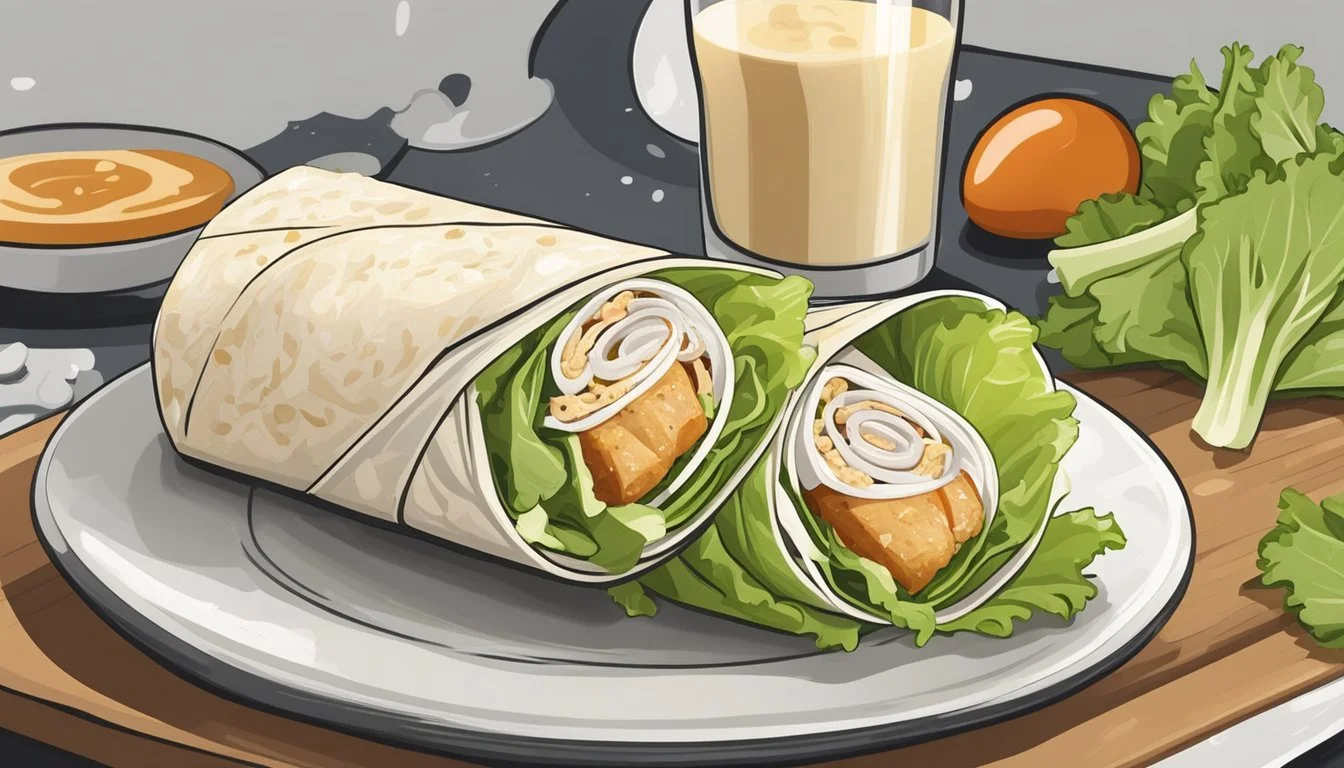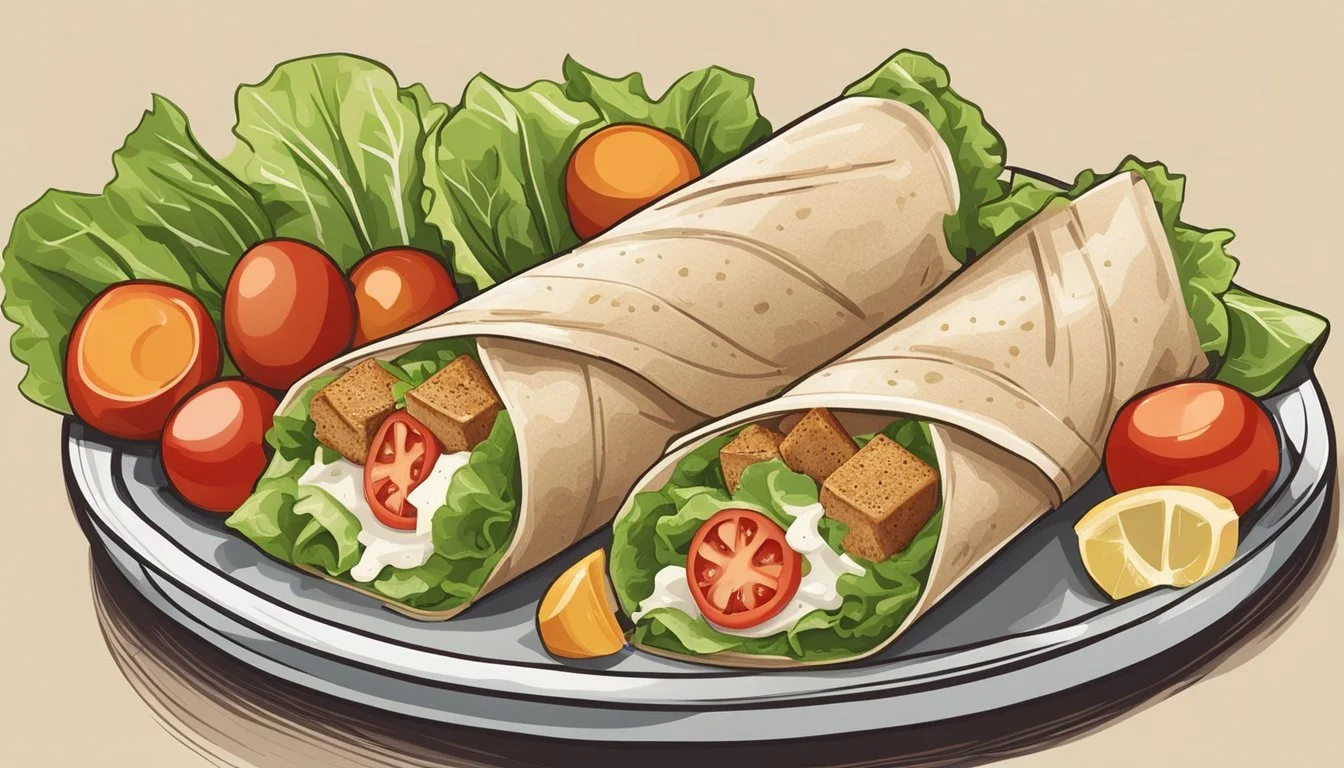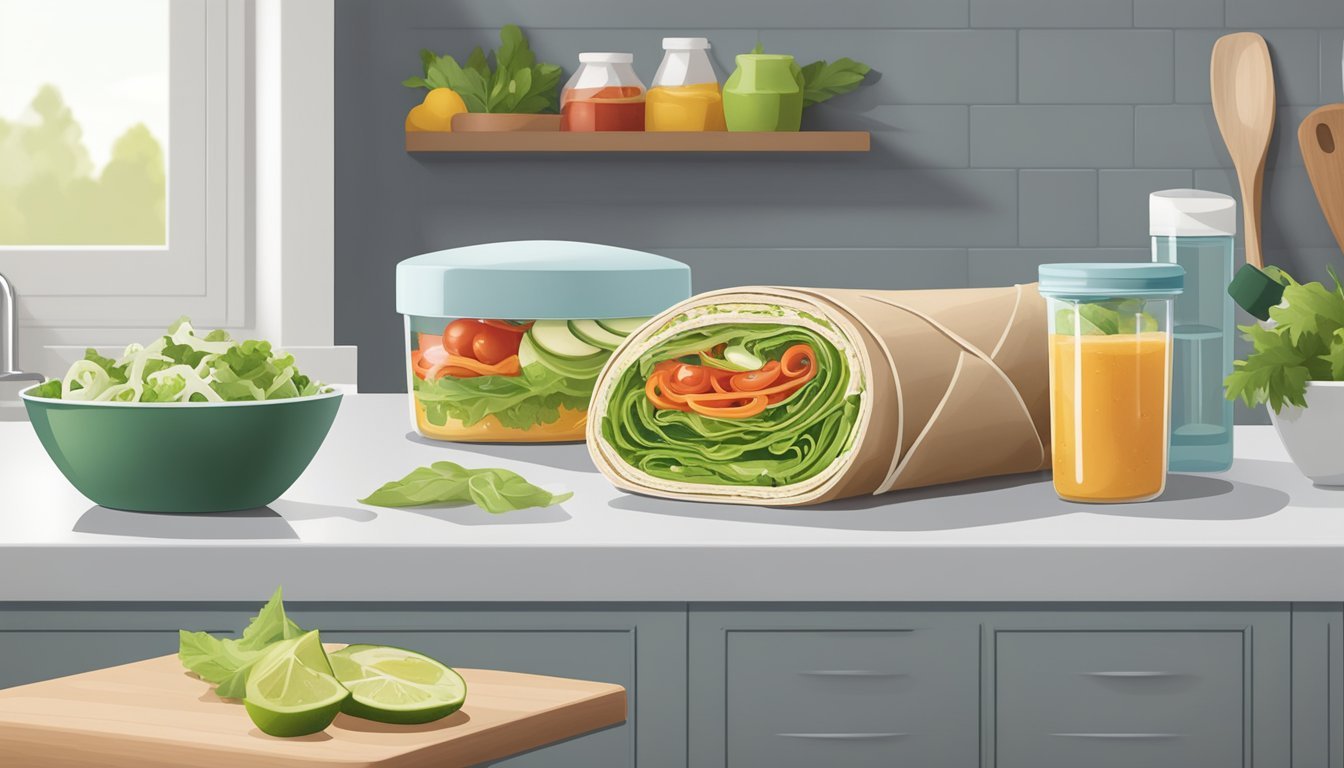How do you eat a Caesar wrap?
A Step-by-Step Guide to Enjoying Your Meal
Eating a Caesar wrap is a delightful way to enjoy the classic Caesar salad in a handy and portable form. The preparation typically involves filling a soft tortilla with grilled chicken, crisp romaine lettuce, Parmesan cheese, and Caesar dressing. The ingredients are often complemented by croutons for added crunch and sometimes bacon, tomatoes, or additional vegetables for flavor variety. The wrap allows for customization to suit individual tastes, which makes it a versatile option for any meal.
To eat a Caesar wrap, one usually begins by holding it with both hands to keep the contents secure. The wrap is consumed from one end, allowing the diner to savor the combined flavors of the ingredients with each bite. The technique in eating a wrap is to do so carefully to prevent the filling from spilling out, especially if it is generously filled. Some prefer to slice the wrap in half, which can make it easier to manage and share if desired.
Caesar wraps are not only a quick and satisfying meal option, but they also strike an appealing balance between convenience and a sit-down meal. They are often chosen as a meal on-the-go, for picnics, or as a lighter, yet substantive, alternative to a traditional sandwich. With just enough elegance from its Caesar salad roots and a touch of practicality from the tortilla, they cater to a broad range of dining occasions.
Understanding Caesar Wraps
A Caesar Wrap combines the classic flavors of a Caesar salad with the convenience of a portable meal. This section explores the origins, essential components, and nutritional content of the Caesar Wrap, a favorite for lunch (What wine goes well with lunch?) enthusiasts.
History of the Caesar Wrap
The Caesar Wrap is a modern take on the traditional Caesar salad, originally created in the 1920s by Italian-American restaurateur Caesar Cardini. The wrap iteration likely emerged as a response to the demand for more handheld and casual dining options, maintaining the salad's core components while enhancing its mobility.
Key Ingredients
A typical Chicken Caesar Wrap includes the following key ingredients:
Romaine Lettuce: Fresh and crisp, it serves as the foundation.
Chicken: Often grilled and sliced; the main protein source.
Caesar Dressing: Creamy with a tangy flavor profile.
Parmesan Cheese: Adds a sharp and salty bite.
Croutons: Often omitted in wraps for ease of eating but included for a traditional crunch.
Tortilla: A large, soft tortilla traditionally holds the ingredients together.
Nutritional Overview
The nutritional content of a Chicken Caesar Wrap can vary, but a standard serving typically contains the following:
Nutrient Amount Calories ~400-600 kcal Fat ~10-30g Saturated Fat ~3-9g Cholesterol ~50-70mg Sodium ~600-1200mg Fiber ~2-4g Sugar Low Iron Varies Potassium Varies Vitamin C Varies Calcium ~15-30% DV Protein ~20-40g
Cheese, particularly Parmesan, and Caesar dressing, being rich in fat, can impact the wrap's calorie and fat content. Meanwhile, the inclusion of chicken and lettuce contributes protein and fiber, respectively, rounding out the meal's nutritional profile.
Preparation Basics
Creating a delectable Caesar wrap begins with careful selection of quality ingredients and precision in every step of preparation.
Selecting Ingredients
For a Caesar wrap, one needs chicken breasts (What wine goes well with chicken breast?), tortillas, romaine lettuce, olive oil, garlic, lemon juice, and other salad components. Ensuring the chicken is fresh and the lettuce is crisp is crucial to the wrap's overall texture and taste.
Making the Caesar Dressing
The Caesar dressing forms the flavor foundation. Its preparation involves emulsifying olive oil with garlic and lemon juice to create a balanced, zesty flavor that complements the chicken and lettuce. One can either follow a traditional recipe or opt for a store-bought dressing of high quality.
Grilling the Chicken
It's important to grill the chicken to an internal temperature of 165°F for safe consumption. Marinating the chicken beforehand with olive oil, lemon juice, and seasonings enhances the flavor. One should cook the chicken on a grill or skillet until it's golden and cooked through, then allow it to cool before slicing into strips.
Preparing the Greens
One must thoroughly wash and chop the romaine lettuce, ensuring it's free of any dirt or grit. The lettuce is then tossed with the Caesar dressing to coat each leaf, creating a uniform flavor profile that will be distributed throughout the wrap.
Assembling the Caesar Wrap
Assembling a Caesar wrap is a straightforward process entailing the arrangement of ingredients on a tortilla, followed by precise folding and wrapping. Mastery of technique ensures a wrap that is both visually appealing and easy to eat.
Layering Components
For a classic Chicken Caesar Wrap, one should start with a large flour tortilla as the base. A chef typically layers the components in the following order:
Filling: In the center of the tortilla, place the cooked chicken—either leftover chicken or rotisserie chicken—chopped or shredded for easier eating.
Greens: Add chopped lettuce, traditionally romaine, on top of the chicken for crunch.
Crunch: Include croutons for added texture, but consider size as large pieces can complicate the wrap's integrity.
Accents: Sprinkle on grated Parmesan cheese and crispy bacon pieces.
Dressing: Drizzle Caesar dressing evenly across the other components.
One should be generous but not excessive with each layer to maintain balance and ensure a cohesive wrap.
Wrapping Technique
Once all components are layered, the technique for wrapping a tortilla is crucial. Here are the steps to create a secure wrap:
Fold the sides of the tortilla inward, over the edges of the ingredient pile, to secure the filling.
From the bottom (the edge closest to the person), roll the tortilla tightly over the ingredients, ensuring the initial folds stay in place.
Continue to roll the tortilla until it is fully wrapped around the ingredients, creating a cylindrical shape.
Some prefer to secure the wrap with toothpicks to hold it together, especially if it's not being eaten immediately.
Serving Suggestions
Once assembled, a Chicken Caesar Wrap can be served immediately or wrapped in parchment for a portable meal. For presentation, a chef might cut the wrap diagonally across the middle, showcasing the layers of ingredients. The wrap is best enjoyed fresh, but it can also be stored in the refrigerator, making it a convenient option for meal prepping.
Recipe Variations and Tips
When creating a Caesar wrap, one has the flexibility to tailor flavors and ingredients to personal tastes or dietary needs. Utilizing various substitutions and adjustments ensures the wrap remains a convenient and satisfying meal.
Alternative Ingredients
Variations:
Tortillas: Replace traditional flour tortillas with whole wheat tortillas for a healthier option.
Protein: Swap out chicken breasts for grilled tofu (What wine goes well with grilled tofu?) or shrimp to diversify protein choices.
Greens: Romaine lettuce can be substituted with spinach or kale for a nutrient-dense twist.
Add-ons: Incorporate diced avocado for creamy richness or add a spread of hummus for a Mediterranean flair.
Substitutions:
Salt: Use kosher salt for its pure flavor and easy-to-control grain size.
Dressings: Experiment with different Caesar dressing variations found on social media platforms like Pinterest, Instagram, or Facebook for unique flavor profiles.
Adapting for Dietary Restrictions
Gluten-Free: Opt for gluten-free tortillas to make the wrap accessible for those with gluten sensitivities.
Low-Carb: For a low-carb version, one can use lettuce leaves as a wrap substitute to reduce carbohydrate intake while still enjoying the classic Caesar taste.
Vegetarian: Eliminate chicken and use chickpeas or marinated tempeh as a protein-rich filling.
Dairy-Free: Select dairy-free Caesar dressing or make a homemade version to cater to dairy restrictions without compromising on flavor.
The inclusion of these tips and variations in a recipe enables individuals to customize their Caesar wrap to suit their dietary preferences while maintaining the essential characteristics of the beloved sandwich.
Storing and Meal Prep
When it comes to Caesar wraps, proper storage is essential to maintain freshness, and strategic meal prep can simplify serving them later. The reader should focus on best practices for storing leftovers and the ways to efficiently prepare Caesar wraps in advance.
Storing Leftovers
One should store leftover chicken Caesar wraps by tightly wrapping each individual wrap in plastic wrap or aluminum foil. The wraps can be refrigerated for up to two days to retain optimum freshness. It's important to store the leftover chicken separately if it's not already mixed with the dressing and other ingredients, as it can last in the refrigerator for up to three to four days.
Chicken: Refrigerate in an airtight container (up to three days).
Prepared Caesar wraps: Wrap individually and store (up to two days).
Make-Ahead Advice
For efficient meal prep, one can prepare components of Caesar wraps in advance. Chopped lettuce, cooked chicken, and other toppings can be stored separately in the refrigerator, allowing for quick assembly right before serving. This process ensures that each wrap is fresh and crisp when it's time to eat.
Prepared chicken: Keep in a container in the refrigerator; utilize within three to four days.
Chopped vegetables: Refrigerate in separate containers, combining only when ready to serve.
When making ahead, the dressing should be applied to the wraps just before serving to prevent the ingredients from becoming soggy. This strategy can save time and make it easier to enjoy a quick and healthy meal on the go.
Engaging with the Community
When enjoying a Caesar wrap, community engagement can enhance the experience through various platforms. A diner might share their culinary creations, participate in discussions, provide feedback, and offer tips across social mediums, which can elevate the joy of this quick and healthy meal.
Sharing on Social Media
Instagram: It is an ideal platform for visually showcasing a beautifully assembled Caesar wrap. Use hashtags like #HealthyEating and #QuickLunch to reach others interested in nutritious meals.
Facebook & Pinterest: Family and friends can find inspiration and share their own variations of the Caesar wrap. On Pinterest, one can contribute to food boards that emphasize kid-friendly and healthy lunch options.
Frequently Asked Questions
Q: What is the yield of a typical Caesar wrap recipe? A: Most recipes cater to 4 servings, making it suitable for family meals.
Q: Where can I find nutrition information for Caesar wraps? A: Nutrition details are often included in the recipe or can be calculated using online tools.
Rating and Reviews
Following a recipe, consumers often leave a review on the original post to provide feedback.
Star Rating: A quick glance gives insight into the popularity and approval of the recipe. The scale typically ranges from 1 to 5 stars.
Review Text: Family cooks or lunch enthusiasts provide details about their experience, such as adjustments made for children or opinions on taste and prep time.
Additional Insights
In exploring the various aspects of enjoying a Caesar wrap, one must consider the health benefits it provides, the culinary techniques for enhancing flavor and texture, and thoughtful pairing suggestions to create a balanced meal.
Health Benefits
A Caesar wrap can be a nutritious option, offering a good source of protein from chicken which is essential for muscle repair and growth. However, to maintain its healthy profile, one should be mindful of the calories, fat, and particularly saturated fat and cholesterol often found in the Caesar dressing and Parmesan cheese. Opting for a homemade Caesar dressing can help manage levels of sodium and sugar, and incorporating whole grain wraps can increase dietary fiber. The wrap could also provide other important nutrients like calcium, potassium, vitamin A, vitamin C, and iron.
Culinary Techniques
The culinary technique of grilling or searing the chicken adds a delightful crunch to the wrap's texture, complementing the croutons. To ensure the chicken is well-cooked yet moist, one can pound it to even thickness before marinating it in a mixture of lemon juice, olive oil, garlic powder, black pepper, and salt. To maintain freshness, the romaine lettuce used in the Caesar salad should be crisp and the croutons should be added last to prevent sogginess.
Pairing Suggestions
When serving a Caesar wrap for dinner or as a main course, pairing it with a light soup or a vegetable side dish can round out the meal. A glass of white wine or iced tea complements the flavors well. If aiming for a lower calorie meal, consider replacing part of the wrap with a side salad to reduce overall calories and fat content.








